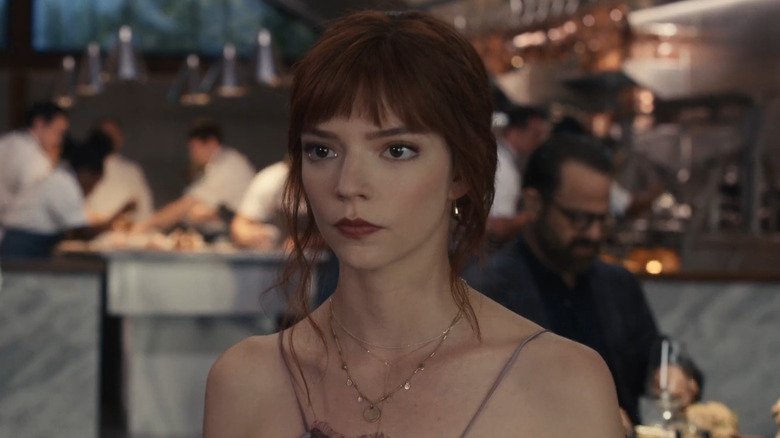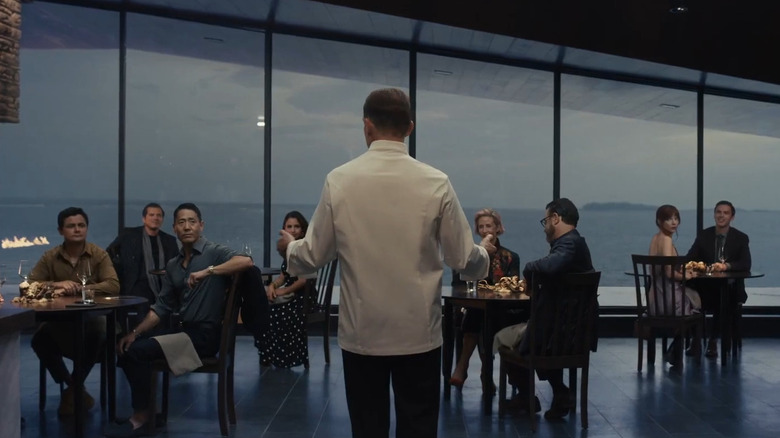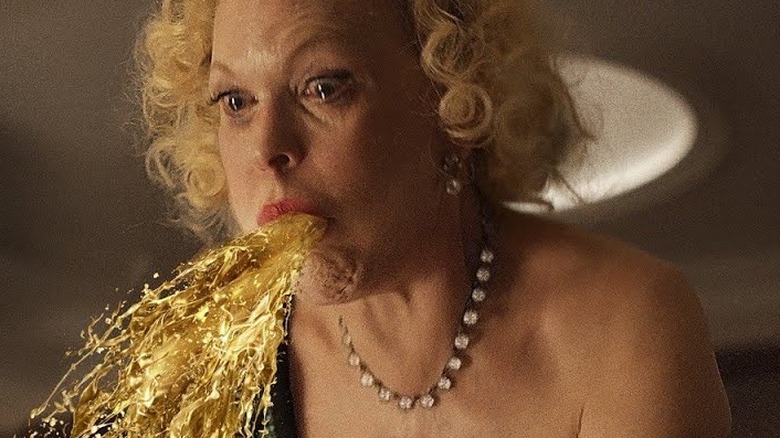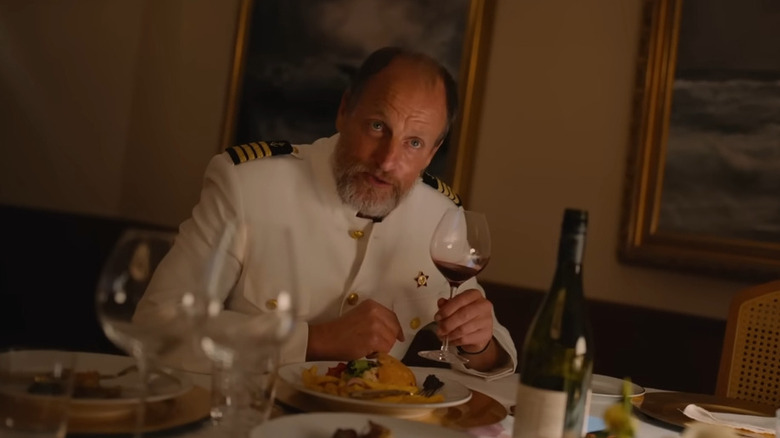How The Menu And Triangle Of Sadness Turn The Dining Area Into A Battlefield
This article contains major spoilers for "The Menu" and "Triangle of Sadness."
When the rich eat everything in their path, the only thing left to do is to make them spew it up, and feed it right back.
Anti-capitalist stories about making fools of the one percent have been around for decades, but with the rate of billionaire schmucks making things difficult for normal folks to have a decent life, it makes sense that there's been a significant influx as a result. Films like "Sorry to Bother You" and "Ready or Not" show the wealthy and powerful through a darkly comedic lens, where you almost have to stifle your laughter in the midst of overwhelming horror.
As of this moment, Mark Mylod's "The Menu" and Ruben Östlund's "Triangle of Sadness" are two of 2022's sharpest social satires. Although different in execution, they share a similar narrative beat. In "The Menu," a group of wealthy diners is invited to a remote island where their extravagantly expensive meal turns out to be a sinister lesson. With "Triangle of Sadness," a similar collective is invited aboard a private yacht, in which they're at the mercy of the high seas and their own egos.
Mylod and Östlund take great pleasure in tormenting these groups for our viewing pleasure. "The Menu" forces the diners to confront their sins head-on. "Triangle of Sadness," meanwhile, toys with its oblivious passengers to the point where they simply can't take care of themselves, as the flawed systems they've built are no longer of use to them on the high seas. Food is ultimately used to teach a deadly lesson.
Monetary retribution
In "The Menu," only those who can casually afford a $1200 dinner are allowed to feast at Hawthorne. As Clef Slowik (Ralph Fiennes) unveils the courses, the diners start getting antsy when the meals are aimed directly at them. The film is set in a room filled with people, where the sins that lead them to the mercy of Slowik's chefs are manifested in the artistry of the dishes themselves. A table of egotistical tech bros are served tortillas with evidence of massive bank fraud printed on them, for example. At the last supper for Hawthorne, Slowik torments his guests, as it's their toxicity that molded him into the soulless chef he's become, and the food reflects that.
Although "Triangle of Sadness" takes place aboard all rooms of the luxury yacht and beyond, the film's centerpiece is that of the dining room sequence. Earlier in the film, we're privy to conversations in this room, where weapons manufacturers, billionaires, and vapid influencers hold all the power. But once dinner time arrives, their food becomes the ultimate poison. They're at the mercy of spoiled dishes that match their rotten souls. It's kind of beautiful in its own way.
The dining room, an area for communal gathering, is turned into an erupting battlefield for their lives. A high-end establishment turns on the parasites who occupy the space with the thing they love most. These diners are spineless dimwits who can hardly perform simple tasks on their own without either threatening or leaning on the support of the workers, which makes it all the funnier, as we are granted access to their hilariously messy downfall.
Let the fluids flow
"The Menu" travels down a point of no return when Slowik unveils a meal he calls "The Mess," where one of his protégés kisses a bullet. Although the Hawthorne Chefs put up a tarp to catch the blood spatter, the room is ultimately stained with the expectations these people, barring escort worker Margot (Anya Taylor-Joy), have placed on workers like him. They have every chance to escape after witnessing something so horrific, but it becomes achingly clear thinking as a collective community is beyond their reason of understanding. I found myself consistently laughing at their absolute uselessness.
Where "The Menu" doles out a twisted form of ironic punishment, "Triangle of Sadness" lets its guests fop over themselves in spectacular fashion. They're unwittingly served rotten food from chefs who are likely underpaid, and as a result, they violently excrete their wicked tendencies through a chorus line of vomit. Even when they've started to paint the dining area, they feel obligated to keep digesting. If you replace the sounds of rich folk losing their lunch with the score of a Buster Keaton flick, you have one of the funniest slapstick comedies in ages.
Mylod and Östlund are methodical and precise in their methods of culinary madness. Their dining rooms are built for extravagant enjoyment, but once that facade is broken, they become hilarious nightmare spaces of abrupt bodily fluids, sterile food, and cheeseburgers.
Ode to a cheeseburger
The food in both films are constructed as art pieces above all else. They hardly resemble anything you would be excited to stuff in your mouth. Each party could care less about what they're eating, and more so the privilege that comes with acquiring it. Is it good because they find it delicious, or because they've been given exclusive access? When their respective ships take a bad turn, in a shocking turn of events, cheeseburgers are popped up as the ultimate means of survival.
In "The Menu," Margot confidently requests a cheeseburger, which reminds Slowik of where his innate passion for cooking came from. By appealing for a class conscious meal of the people, she's saved from Hawthorne's collective murder/suicide pact. "Triangle of Sadness" is a bit of a different beast, however, as the one who orders the burger dies later in the film. But when it comes to the dining portion, the drunken, yet rational Captain Smith (Woody Harrelson) avoids everyone else's bodily shutdown simply because he requested something simple and delicious.
As our natural resources dwindle due to the kind of socialite sycophants present in both films, putting an absorbent price tag on art pieces disguised as food seems so insidious. Their privilege shields them from realizing the damage they have on something that should be relatively accessible. In their own ways, "The Menu" and "Triangle of Sadness" brilliantly transform an elegant safe space into their worst nightmare. While the world crumbles, why not go out with a bleggghhhh?
"The Menu" and "Triangle of Sadness" are now playing in theaters nationwide.



